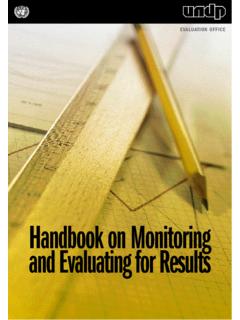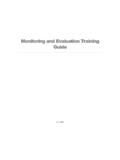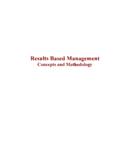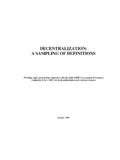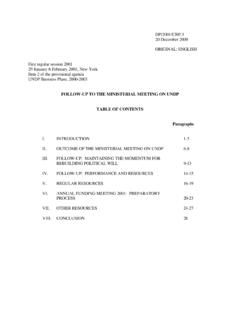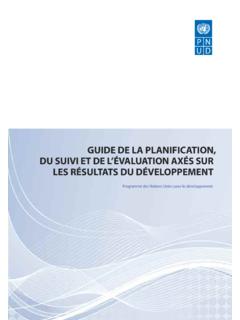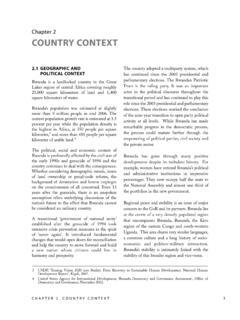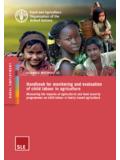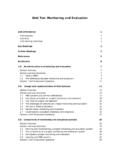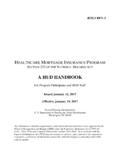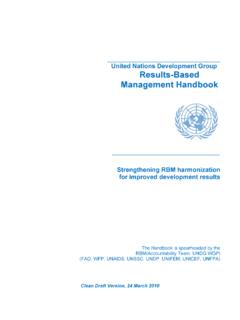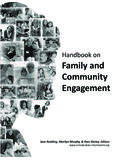Transcription of Handbook on Planning, Monitoring and Evaluating for ...
1 Handbook ON PLANNING, Monitoring AND Evaluating . FOR DEVELOPMENT RESULTS. United Nations Development Programme Handbook ON PLANNING, Monitoring AND Evaluating FOR DEVELOPMENT RESULTS. Copyright UNDP 2009, all rights reserved. Manufactured in the United States of America. Printed on recycled paper. United Nations Development Programme One United Nations Plaza New York, NY 10017, USA. Handbook Web site: Design: Suazion, Inc. (NY, ). Production: Office Supplies (NY). FOREWORD. Supporting national capacity development for poverty reduction and the attainment of the Millennium Development Goals lies at the very heart of UNDP's mandate.
2 That means that we must work with programme countries to assist in the formulation of those strategies, policies, structures, and processes, which will have system-wide developmental impact. Active in 166 countries around the world, UNDP must be relevant to the emerging needs of programme countries. We must have a clear vision of the direction in which we need go and the outcomes we want to help achieve. We must be able to respond quickly and appropriately to challenges and opportunities. Results-based management provides a set of principles, approaches, and tools which can help us achieve these goals.
3 By always trying to answer the so what difference does our intervention make? question, we will keep our focus on how we can support real and sustainable improvements being made in the lives of those we serve. This, in turn, requires us to embrace a culture of evaluation. The tremendous store of knowledge which UNDP has, and has access to, including the lessons learned from evaluations, should more fully inform our programming and our decision making. I hope that the publication of this Handbook will help us and our partners to be even clearer about the higher-level results we want to achieve; to develop and act on strate- gies to achieve those results; to use systematically lessons drawn from evaluations to make decisions; and, ultimately, to improve our contribution to the advancement of human development.
4 Helen Clark Administrator Handbook ON PL AN N IN G, M ON ITORIN G AN D E VALUATIN G FOR D E VE LOPM E N T RE SU LTS i PREFACE. This 2009 version of the Handbook on Planning, Monitoring and Evaluating for Development Results' aims to support UNDP in becoming more results-oriented and to improve its focus on development changes and real improvements in people's lives. It replaces and updates the previous Handbook from 2002. It was a breakthrough in driving the effective application of the results-based management approach in programming and performance management.
5 The Handbook recognizes that planning, Monitoring and evaluation require a focus on nationally owned development priorities and results, and should reflect the guiding principles of national ownership, capacity development and human development. Globally, there has been a significant shift away from the project approach in favour of programme and national approaches. All partners and members of the Executive Board expect UNDP to demonstrate tangible results in development cooperation. UNDP also faces intensified calls for accountability to citizens for how resources are used, what results are achieved, and how effective these results are in bringing about progress in human development.
6 In June 2006, a UNDP Evaluation Policy was approved by the Executive Board. In 2007, an independent evaluation of the adoption and use of results-based management in UNDP found that UNDP continued to demonstrate a weak results culture despite notable progress on some fronts. The evaluation recommended that UNDP improve its capacities to manage for outcome-level change. This Handbook , therefore, complements the programme and operations policies and procedures by providing practical guidance on how to plan, monitor and evaluate for development results.
7 The Handbook cannot, on its own, foster a culture of results in UNDP or among its partners. However, together with other initiatives, we hope it will make a significant difference. This updated Handbook marks a departure from the previous publication. First, recognizing that results planning is a prerequisite for effective programme design, Monitoring and evaluation, the revised Handbook integrates planning, Monitoring and Handbook ON PL AN N IN G, M ON ITORIN G AN D E VALUATIN G FOR D E VE LOPM E N T RE SU LTS iii evaluation in a single guide.
8 Second, the Handbook reflects the requirements and guiding principles of the evaluation policy, including national ownership, which is now mainstreamed throughout the cycle of planning, Monitoring and evaluation. Third, the revised Handbook includes a comprehensive chapter on evaluation design for quality assurance to guide UNDP staff and evaluators in ensuring professional standards of quality in evaluation. There will be online training and regional workshops to support the application of the Handbook across the organization at all levels.
9 While the primary audience for the Handbook is UNDP staff, we hope that it will contribute to the efforts of all our partners who, like UNDP, strive towards greater development effectiveness. To facilitate wider dissemination of the publication, in addition to the printed version of this Handbook , the document is available on the UNDP website at This Handbook is a joint product of the Bureau for Development Policy, Evaluation Office and Operation Support Group. We would like to thank colleagues in these units who helped conceive, draft and refine the Handbook over a number of iterations.
10 Special thanks go to the core authors of the Handbook : Asoka Kasturiarachchi and Thomas Eriksson of the Bureau for Development Policy, Stephen Rodriques of the Operation Support Group, and Azusa Kubota of the Evaluation Office, who also marshaled the process as the Task Manager for the Handbook . Nurul Alam of the Evaluation Office provided overall quality assurance and guidance throughout the process. The revision of the Handbook benefited from the commitment of many individuals, who provided substantive and technical inputs to the various drafts.
